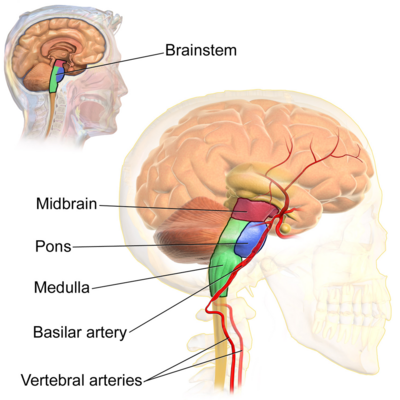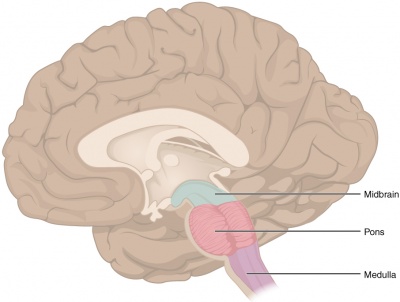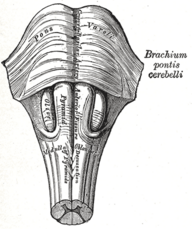Brainstem
Original Editor - Wendy Walker
Lead Editors - Lucinda hampton, Olajumoke Ogunleye, Stacy Schiurring, Pacifique Dusabeyezu, Evan Thomas, Kim Jackson, Wendy Walker, Garima Gedamkar, Aya Alhindi, WikiSysop, Carina Therese Magtibay, Tarina van der Stockt and Daniele Barilla
Brainstem Overview[edit | edit source]
The brainstem is a stalk-like projection of the brain extending caudally from the base of the cerebrum. It function is to bridge communication between the cerebrum with the cerebellum, and spinal cord.[1]
- It is composed of 3 sections in descending order: the midbrain, pons, and medulla oblongata.
- It is responsible for many vital functions of life, such as (1) breathing, (2) consciousness, (3) maintaining blood pressure, (4) heart rate, and (5) sleep regulation.
- The brainstem contains both collections of white and grey matter
- The grey matter within the brainstem consist of nerve cell bodies and include important brainstem nuclei, for example, ten of the twelve cranial nerves arise from their cranial nerve nuclei located within the brainstem.
- The white matter tracts of the brainstem involve neuron axons traveling between the cerebrum, cerebellum, and spinal cord to the peripheral nervous system. Most of the cell bodies of these white matter tracts originate outside the brainstem, however some are located within the brainstem as well. These tracts travel both to the brain (afferent) and from the brain (efferent) such as the somatosensory pathways and the corticospinal tracts, respectively.
- Although it is the most evolutionary ancient part of our brain, the brainstem is still very complex and important. It ensures the vital functions necessary to support those areas continue uninterrupted.[2]
Brainstem Anatomy and Structure[edit | edit source]
The brainstem is located in the posterior cranial fossa of the skull [3]. The brainstem can be divided into three regions or components: (1) the midbrain, (2) the pons, and (3) the medulla.
Recall that the nervous system is a continuous neuronal network. When looking at the brain stem in situ:
- superiorly or ventrally , the midbrain is continuous with the cerebral hemisphere
- inferiorly or caudally, the medulla is continuous with the spinal cord
- posteriorly, the pons and medulla are separated from the cerebellum by the fourth ventricle
Midbrain (Mesencephalon)[edit | edit source]
The midbrain is the smallest portions of the brainstem and is continuous with the diencephalon (area of the brain which contains epithalamus, thalamus, hypothalamus, and ventral thalamus and the third ventricle).
Anterior midbrain:[edit | edit source]
- contains the cerebral peduncles which are a pair of fibre bundles. separated by the interpeduncular fossa.
- the corticospinal tract, a descending motor tract between the cortex and the spinal cord, is found in the cerebral peduncles
Posterior midbrain:[edit | edit source]
- the tectum (i.e. the roof) of the midbrain is formed by two pairs of rounded protrusions: the superior and inferior colliculi:
- superior colliculi are involved in visual processing and eye movements
- inferior colliculi are involved in auditory processing
- also connects and communicates with the cerebellum posteriorly through the superior cerebellar peduncles
Clinically relevant brainstem nuclei found in the midbrain:[edit | edit source]
- Red nuclei, located anterior medially at the level of the superior colliculus. The exact function of the red nuclei is still being investigated, however it is likely involved in locomotor functions and in the execution of "simple, stereotyped movements," and specialized movements of the upper limb.[4] The red nuclei is the origin of the descending rubrospinal tract. The rubrospinal tract functions primarily to transmit signals into the red nucleus from the cerebral motor cortex and cerebellum to the spinal cord.[5]
- Substantia nigra, found at the base of the midbrain. The substantia nigra is rich in dopamine neurons and is considered part of the basal ganglia. This paired nuclei has a critical role in modulating motor movement and reward functions. In Parkinson's, neurodegeneration occurs due to death of dopamine producing cells in the substantia nigra, which causes the hallmark movement dysfunction seen with this disease process.
- Cranial Nerve IV (CN IV, the trochlear nerve) is found Just inferior to the inferior colliculi. CN IV is unique among its fellow cranial nerves as it ss the only one to emerge from the posterior surface of the brainstem.[6]
- Cranial nerve III (CN III, the oculomotor nerve) . The oculomotor nerve originates at the oculomotor sulcus within the interpeduncular cistern.
Pons (metencephalon)[edit | edit source]
The next portion of the midbrain is the pons, located between the midbrain and the medulla. The medulla is notable for its rounded shape and "bridges" (pons is latin for bridge) or connects the two cerebellar hemispheres. It also forms important connections with the cerebellum via fibre bundles known as the cerebellar peduncles.
Anterior pons:[edit | edit source]
- Basilar artery runs through the basilar groove on the anterior surface of the pons
- Nerve tracts found in the anterior pons: pontocerebellar tracts through the middle cerebellar peduncles, these assist with movement coordination and breathing modulation; the corticospinal tracts also run through the base of the pons
Posterior pons:[edit | edit source]
- Connects and communicates with the cerebellum via the middle cerebellar peduncle
- Posterior portion of the pons also forms part of the floor of the fourth ventricle
Clinically relevant brainstem nuclei found in the pons:[edit | edit source]
- Cranial nerve V (CN V, the trigeminal nerve), exits from the superior anterior lateral pons
- Cranial nerve VI (CN VI, the abducens nerve)
- Cranial nerve VII (CN VII, the facial nerve)
- Cranial nerve VIII (CN VIII, the vestibulocochlear nerve) CN VI, VII, and VIII emerge medially to laterally at a groove formed where the pons meets the medulla
Medulla (myelencephalon)[edit | edit source]
The last and more distal or caudal section of the brainstem is the medulla (also known as the medulla oblongata). The medulla is continuous with the spinal cord and joins at the level of the foreman magnum.
"Bulb" is an archaic term for the medulla oblongata, the word bulbar (e.g. bulbar palsy) is retained for terms that relate to the medulla oblongata. The word bulbar can refer to the nerves and tracts connected to the medulla, and also by association to the muscles thus innervated, such as those of the tongue, pharynx and larynx.[7]
Anterior medulla:[edit | edit source]
- The pyramids are paired enlargements on the anterior medulla. They carry motor fibers to the motor cortex of the cerebrum and to the spinal cord and PNS beyond. The pyramids are also clinically significant as they are the location of the crossing (or decussation) of the majority of motor fibres in what will become the lateral corticosteroidspinal tract in the spinal cord, the motor fibres which do not cross become the medial corticospinal tract.
- The olives are oval protrusions formed by the underlying olivary nuclei. They are found lateral to the pyramids. The olives are involved in the auditory nervous system.
- The inferior cerebellar peduncles on each side connect the medulla to the cerebellum.[6]
- The spinothalamic tract ascends through the lateral medulla outside of the pyramids, carrying pain and temperature sensations.
Posterior medulla:[edit | edit source]
- A posterior median sulcus separates the fibre bundles fasciculus gracilis and fasciculus cuneatus, which contain the ascending posterior column tracts carrying sensory information up from the spinal cord.
- Fibres carrying information from the lower extremities and the trunk synapse at the gracilis nucleus and fibres carrying information from the upper extremities and the upper body above T6 (except for the face and ears) synapse at the cuneate nucleus.
- Fibres leaving these nuclei will decussate at the level of the medulla after which they form the medial lemniscus tracts and continue traveling up towards the thalamus. Together, this is known as the posterior column-medial lemniscus pathway which carries information about fine touch, proprioception, and vibration sensations.
- Forms a portion of the floor of the fourth ventricle [6]
Clinically relevant brainstem nuclei found in the medulla:[edit | edit source]
- Cranial nerve IX (CN IX, the glossopharyngeal nerve)
- Cranial nerve X (CN X, the vagus nerve)
- Cranial nerve XI (CN XI, the accessory or spinal accessory nerve)
- Cranial nerve XII (CN XII, the hypoglossal nerve)
Brainstem Nerve Tracts[edit | edit source]
The reticular formation is a network of brainstem nuclei and neurons with a vast number of connections to different and far-reaching systems. It extends from the spinal cord, through the brainstem and into the diencephalon. The reticular formation does not have clearly defined boundaries and receives input from various nerve tracts including (1) spinothalamic tracts, (2) spinoreticular tracts, the (3) dorsal column-medial lemniscus pathway, (4) visual pathways, (5) auditory pathways, (6) vestibular pathways, and (7) cerebelloreticular pathways. The reticular formation has efferent fibers to the (1) thalamic nuclei, (2) cerebellum, (3) red nucleus, (4) corpus striatum, (5) substantia nigra, (6) hypothalamus, and (7) subthalamic nucleus.
- it plays a role in vital functions necessary for survival, such as consciousness, heart and respirator rates, autonomic regulation of blood pressure, as well as movement coordination, postural reflexes, taste, and wakefulness and sleep.[6]
Motor Tracts[edit | edit source]
- Corticospinal Tracts are a collection of axons that carry movement-related information from the cerebral cortex to the spinal cord. These tracts allow the cerebral cortex to connect to spinal motor neurons and control movement of the torso, upper and lower limbs..
- Corticobulbar Tracts are composed of the upper motor neurons of the cranial nerves. The muscles of the face, head and neck are controlled by the corticobulbar system, which terminates on motor neurons within brainstem motor nuclei.
Sensory Tracts[edit | edit source]
- Spinothalamic Tract (or Anterolateral System): Information from the trunk and limbs is carried to the sensory cortex and the cerebellum. Two systems ascend to the cerebral cortex, the dorsal column-medial lemniscal (DCML) system and the anterolateral (AL) system. These paralleled ascending systems each relay different information, however, there remains redundancy between the two pathways.
- These neurones carry information regarding pain, thermal sensation, course touch and pressure
- Dorsal Column-Medial Lemniscus pathway is one of the ascending tracts by which sensory information from the peripheral nerves is transmitted to the cerebral cortex.
- It deals with the conscious appreciation of fine touch, 2-point discrimination, conscious proprioception, and vibration sensations from the body except the head.
- Trigeminal Lemniscus and Spinotrigeminal Tract
- Carries information about pain and temperature sensory input from the face enters the brainstem via CN V[6]
- Lateral Lemniscus
- carries auditory information from the cochlear nuclei via CN VIII[6]
Blood supply of the Brainstem[edit | edit source]
The blood supply into the brain comes from the vertebral and internal carotid arteries. The vertebral arteries supply the brain stem directly. The paired vertebral arteries come together on the anterior brainstem to form the basilar artery, which lies in the basilar groove on the pons. The network formed by the vertebral and basilar arteries is called the vertebral-basilar system.
- The midbrain is supplied by the superior cerebellar arteries and posterior cerebral arteries
- The pons is supplied by the basilar artery and its branches. This includes the anterior inferior cerebellar arteries, the pontine branches or paramedian arteries, and superior cerebellar arteries
- The medulla oblongata is supplied by the vertebral arteries and their branches, the anterior spinal artery, the posterior spinal arteries, and the posterior inferior cerebellar arteries
Clinical Significance[edit | edit source]
Significant clinical problems can affect the brainstem such as stroke, malignancy, demyelinating processes, and many more.
- Multiple Sclerosis, with visual problems including blurred double vision being a common early symptom of multiple sclerosis (MS). Cerebellar and brainstem (pyramidal) symptoms are common in the early stages of MS. A study published in 2020 suggests that those patients that present with early brainstem symptoms have a better prognosis, and develop disability slower, than those who present with early cerebellar symptoms.[8]
- Stroke affecting the brainstem can cause severe symptoms which include:
- Problems with vital functions, such as breathing - frequently resulting in death.
- Difficulty using with chewing, swallowing, and speaking.
- Weakness or paralysis in the arms, legs, and/or face.
- Problems with balance or sensation.
- Hearing loss
- Vision problems
- Vertigo
- Locked-in Syndrome
- Coma [9]
- Hemiballismus from damage to the subthalamic nucleus.
- Thalamic pain syndrome
- Injury to or degeneration of dopaminergic neurons in substantia nigra resulting in Parkinson’s.
- Wallenberg stroke (spinothalamic tract, spinal trigeminal tract, hypothalamospinal tract, vestibular nuclei).
- Cerebellar tonsillar herniation (sudden respiratory and cardiac arrest due to compression of the medulla).
- Medial pontine syndrome (abducens nerve, corticospinal tract, medial lemniscus).
- Central pontine myelinolysis from the rapid correction of hyponatremia, which can result in seizures, ataxia, and disturbed consciousness.
- Diffuse intrinsic pontine glioma (DIPG) is a type of fast-growing brain tumour that can grow in the pons of the brain stem. It is a form of childhood cancer.
- Recent research into Long COVID, a post-viral illness affecting COVID-19 survivors, is suggesting a link between symptoms such as fatigue, dyspnea, gastrointestinal and cardiac issues, cognitive impairments, and myalgia with viral induced dysfunction to the brainstem.[10][11]
The 9 minute video below gives a good summary of brainstem and stroke[12]
References[edit | edit source]
- ↑ Brainstem. Kenhub.
- ↑ Neuroscientifically challenged: Know your brain [Internet]. 2014 [cited 9th January 2021].
- ↑ Nolte J. The Human Brain: An Introduction to its fuctional Anatomy. St. Louis: Mosby, 1993.
- ↑ Basile GA, Quartu M, Bertino S, Serra MP, Boi M, Bramanti A, Anastasi GP, Milardi D, Cacciola A. Red nucleus structure and function: from anatomy to clinical neurosciences. Brain Structure and Function. 2021 Jan;226:69-91.
- ↑ Lee J, Muzio M. Neuroanatomy, Extrapyramidal System [Internet]. 2022 [cited 01/June/2024]. Available from:https://www.ncbi.nlm.nih.gov/books/NBK554542/
- ↑ 6.0 6.1 6.2 6.3 6.4 6.5 Basinger H, Hogg J. Neuroanatomy, Brainstem [Internet]. 2023 [cited 01/June/2024]. Available from: https://www.ncbi.nlm.nih.gov/books/NBK544297/
- ↑ World Heritage Encyclopedia. Medulla Oblongata. http://www.ebooklibrary.org/Articles/Medulla%20oblongata?&Words=Medulla (Accessed 8 April 2017).
- ↑ Le M, Malpas C, Sharmin S, Horáková D, Havrdova E, Trojano M, Izquierdo G, Eichau S, Ozakbas S, Lugaresi A, Prat A. Disability outcomes of early cerebellar and brainstem symptoms in multiple sclerosis. Multiple Sclerosis Journal. 2021 Apr;27(5):755-66.
- ↑ Brain Injury Explanation [Internet]. [accessed 8 April 2017]. Available from: http://www.braininjury-explanation.com/consequences/impact-by-brain-area/brainstem
- ↑ Yong SJ. Persistent brainstem dysfunction in long-COVID: a hypothesis. ACS chemical neuroscience. 2021 Feb 4;12(4):573-80.
- ↑ Moghimi N, Di Napoli M, Biller J, Siegler JE, Shekhar R, McCullough LD, Harkins MS, Hong E, Alaouieh DA, Mansueto G, Divani AA. The neurological manifestations of post-acute sequelae of SARS-CoV-2 infection. Current Neurology and Neuroscience Reports. 2021 Sep;21:1-7.
- ↑ Basinger H, Hogg JP. Neuroanatomy, Brainstem. StatPearls [Internet]. 2020 [cited 9 January 2021]. Available from:. https://www.ncbi.nlm.nih.gov/books/NBK544297/
- ↑ Soton brain hub Brainstem Stroke Syndromes Available from: https://www.youtube.com/watch?v=qxiRfP9XmpE (last accessed 28.11.2019)










